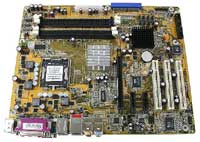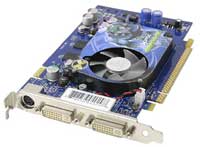Gaming Buyer's Guide - November 2004
by Jarred Walton on November 21, 2004 5:54 PM EST- Posted in
- Guides
Intel Budget Gaming System
At the lowest end of the spectrum, AMD doesn't have quite as much of an advantage in performance over Intel, since the CPU is less of a bottleneck, and there is one item that Intel can offer which AMD cannot (yet): PCI Express. Suffice it to say that especially for die-hard Intel fans, they are not a terrible choice, although they do cost slightly more. Here is our best attempt at matching the Budget AMD system's price and performance.| Budget Intel Pentium 4 System | ||
| Hardware | Recommended Component | Price |
| Processor | Pentium 4 520 2.8 GHz 1MB Cache | 158 |
| Motherboard | DFI 915P-TAG i915P | 118 |
| Memory | 1x512MB Mushkin Basic 2.5-4-4 | 75 |
| Video Card | XFX GeFORCE 6600GT 128 MB | 178 |
| Hard Drive | Seagate Barracuda 80GB EIDE model 7200.7 | 59 |
| Optical Drive | NEC DVD+/-RW Drive Model 3500A | 72 |
| Case and Power Supply | Athenatech A602 Black/Silver with 350W PSU | 62 |
| Display | Samsung 793DF 17 Black/Silver CRT (1280x1024@75 Hz) | 139 |
| Speakers | Logitech Z-640 5.1 | 52 |
| Keyboard and Mouse | Logitech Optical Desktop Combo | 26 |
| Bottom Line | 939 | |
 Click to enlarge. |
 Click to enlarge. |
Another drawback is that dual-channel RAM helps the Pentium 4 more than it does the Athlon 64, so using only one DIMM is going to cut into that performance boost a bit. If you plan on adding 512MB of RAM in the near future, that's not too big of a problem. Otherwise - and we hesitate to say this as they may not be of much use in future systems - using two 256 MB DIMMs will cost about the same as a single 512 MB DIMM. The extra $70 or so spent on an Intel system could be put into other items like a better graphics card or a faster CPU, and AMD also has the 64-bit factor to consider. This is why we still give AMD our primary recommendation, but it really is a close match-up in this price bracket.
Besides shipping PCI Express support, Intel also has their HyperThreading feature, which can help in certain multi-tasking applications. We have not yet seen any performance benefit to HyperThreading in the gaming realm - quite the reverse, in fact, as most games run a few percent slower with HTT enabled - but that could change in the future. With both AMD and Intel shifting away from increasing clock speeds to multi-core designs, it would make sense that games at some point will need to shift to a multi-threaded programming environment in order to extract the most performance from the processor. HTT ends up being nothing that we are overly concerned with as far as games go, but it's still there and it could come into play in the next year or two.
If you feel that our budget recommendations are almost impractical, just take that as an indication of the difficulty of selecting parts for this price segment. These three platforms are all very capable, however, and none of them is truly a bad choice. If you're the type of person who upgrades parts frequently - i.e. more than twice a year - over the life of your system, the socket 939 and socket 775 platforms will be a better choice. From a pure price standpoint, socket 754 still wins out.










70 Comments
View All Comments
nghtdvl - Monday, November 22, 2004 - link
Good guide, thanks.I'm still waiting to see some NF4 boards before getting a new system, though. I'm hoping the Gigabyte GA-K8NXP-939 will perform well.
Glassmaster - Monday, November 22, 2004 - link
#7: The Gigabyte board isn't worth the trouble, if you really want an nForce 3 get the MSI K8N Neo2. There's a good reason why Anandtech isn't recommending the Gigabyte board.Jarred: Do you guys actually build and stress test these systems? Over at the offical AMD Athlon 64 troubleshooting forums, the most common problem we see is weak power supplys without enough amps on the 12V rail causing stability issues or even failing to POST. We generally recommend only PSUs with at least 18-20A on the 12V rail for the Athlon 64. I tried to look up the specs on that generic 350W PSU, but was unable to find them. Even the 350W Antec is difficult to find specs for. I know you are trying to save money, but what about the Antec True Power 380W (18A on 12V rail) for low end, and Antec True Power 430W (26A on the 12V rail) for the mid-range?
Glassmaster.
Brian23 - Monday, November 22, 2004 - link
I like the fact that the guide reminds people that the price of SLI is too high for anyone but the most hardcore gamer.crazycarl - Monday, November 22, 2004 - link
i like the new format for the buyer's guides!bsrealm - Monday, November 22, 2004 - link
great guide, but i see there is no mention about RAIDing the SATA drives.. wouldnt that improve performance (atleast while installing and reading the game files)i am also a graphic designer and i guess while loading large files RAID would help..
and i agree with drpepper - video editors' guide please!!!
xsilver - Monday, November 22, 2004 - link
thanks jarred -- im just laughing to see the same situation as pci video cards -- I still see tnt2 pci go for $50 on ebay! -- what a joke.... I don't want to be one of those stuck with something that is going to cost more in the long run :)drpepper1280 - Sunday, November 21, 2004 - link
Thank you,This was the way buyers guiders were meant to be done. Now for one on video editing!
ariafrost - Sunday, November 21, 2004 - link
One thing that bothers me... the keyboards and mice listed are "decent", but if you are wanting the bleeding edge in gaming, WHY would you buy an Intellimouse? Get something better... like an MX510 at least...DEMO24 - Sunday, November 21, 2004 - link
Im not sure why the VP912b was listed instead of a Dell 2001fp. the 2001 is larger and has a larger resolution. true it costs more but this is a all out system.drifter106 - Sunday, November 21, 2004 - link
as you indicated it does come off somewhat different from the norm that I have seen in previous guides...but neverless thanks for the time and effort... it makes me consider possible alternatives for my upcoming buildoh yea... i'll check back tommorrow and see how many winers come thru...hehe